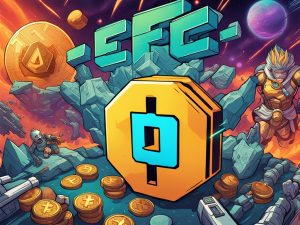What Are Bitcoin Miners Up Against in 2024?
Alright, let’s dive into the wild world of Bitcoin and its mining ecosystem. You know, if you’re even vaguely into crypto, you can’t ignore what’s happening with Bitcoin lately. Things have been buzzing since the SEC finally greenlit a bunch of Bitcoin ETFs back in January 2024, pushing the price well past $70k! Not too shabby, right? But don’t get too comfy — the volatility is still there, and the mining scene is feeling the heat even more than before.
Key Takeaways
- Bitcoin ETFs gaining approval significantly impact Bitcoin prices.
- Mining operations are increasingly sensitive to Bitcoin’s price swings.
- There’s a push towards alternative energy sources for mining.
- Miners are exploring AI and token holding as new revenue streams.
- The hash rate trends upward, posing challenges and opportunities for miners.
Mining: A Love-Hate Relationship
So, let’s break it down. The mining industry is in a bit of a pickle. With the market getting more speculative and sensitive to rumors—like those juicy Bitcoin ETFs—miners are scrambling to keep up. For example, many miners didn’t seize the moment when prices soared with ETF news. This volatility can be a double-edged sword; it creates opportunity but also reflects the rollercoaster of risks inherent in crypto investments.
I mean, just think about it. When Bitcoin was flying high hitting those new valuations, the mining rewards from last halving were already feeling, shall we say, uncomfortably tight. It’s like trying to squeeze into an old favorite pair of jeans after the holidays. Not a good look!
The Hash Rate: A Vital Metric
Let’s talk about the hash rate—basically the computational power dedicated to mining Bitcoin. Current projections say we could hit 765 EH/s (that’s exahashes per second, by the way) soon. Higher hash rates usually mean more competition and, interestingly enough, higher costs for electricity and equipment. Think of it as more members joining a gym; the more folks trying to do the same exercise, the harder it is to see results without spending more on gym membership fees and fancy protein powders.
What Does This Mean for Miners?
- Cost Pressure: With rising expenses, profit margins can get squeezed tighter. Miners might need to get smarter about their operation costs.
- Market Sensitivity: Miners’ revenues are increasingly dependent on the price of Bitcoin. If prices drop, so do profits. Simple as that.
- Strategic Adjustments: If you’re mining, you’ll want to consider your strategy pretty seriously moving forward.
Sustainability: Can We Mine Sustainably?
Now, let’s address the elephant in the room: environmental concerns. Crypto mining has taken quite a bit of heat for its insane energy consumption. Experts suggest that shifting to alternative energy sources could reduce carbon footprints by a whopping 63% by the year 2050.
Holy smokes! Imagine if miners really commit to renewable options like solar or wind. Not only would they be saving the planet, but they’d likely save a few bucks too when energy bills start adding up.
Steps for Miners to Embrace Sustainability:
- Evaluate Current Energy Sources: If you’re still plugged into traditional grids, consider what would happen if you switched to solar or wind.
- Invest in Green Technologies: Investing early in your infrastructure could pay off long-term as regulations tighten and the world becomes more eco-conscious.
- Collaborate for Innovation: Joining hands with or pooling resources with other miners could drastically reduce costs associated with transitioning to renewable energy.
AI and the Future of Mining
Alright, now let’s sprinkle a bit of tech magic in here. Some miners are turning to AI to bolster their operations. You know what they say: if you can’t beat ‘em, distract them with something shiny! Holding onto tokens rather than mining them has become somewhat of a trend. This ain’t just a whim; it’s like having a safety net while the market continues to oscillate.
Why AI?
- Operational Efficiency: AI can help optimize mining rigs and make them run smoother.
- Market Insights: Predictive analytics can offer miners insights into market movements, helping them to strategize better.
- Cost Management: By analyzing spending and generating reports, AI can help miners pinpoint where they can save money.
Wrapping It Up: A Brave New World for Miners
So, what we’ve got here is a shifting landscape for Bitcoin miners. You’ve got rising prices leading to potential profits but also increased expenses and environmental scrutiny. The game is changing, and miners are kinda like surfers, trying to catch the next big wave while avoiding wipeouts.
What does this mean for potential investors? Well, it’s worth keeping a close eye on how miners adapt. If they embrace alternative energy or AI, you could be looking at a more stable sector.
Now, here’s something to chew on as we close out this convo: with all these shifts, do you think the traditional model of Bitcoin mining can survive? Or is it time for a revolutionary change? Let me know your thoughts!





 By
By
 By
By
 By
By
 By
By
 By
By